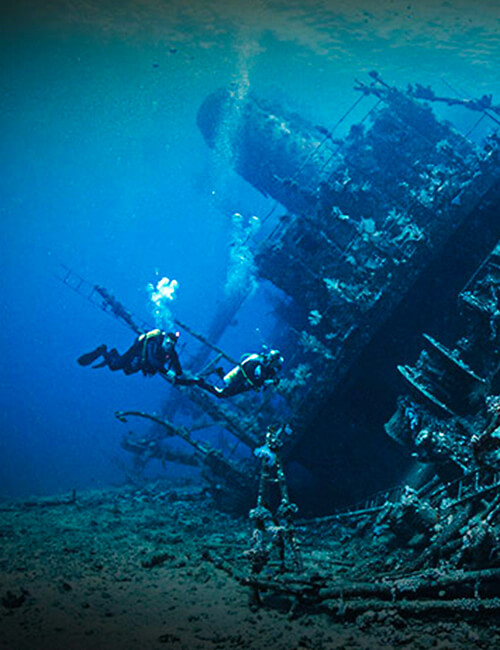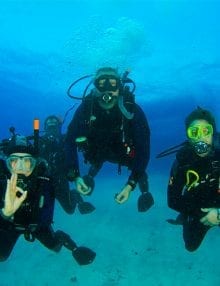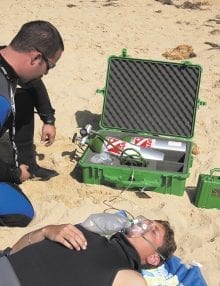Description
We can offer a number of PADI speciality courses so that you can extend your experience and even work towards obtaining your Master Scuba Diver rating if you wish. To become a Master Scuba Diver, you need to be a Rescue Diver, completed five speciality courses and have logged a minimum of 50 dives.
Here are a few that we offer. If there are any that you are interested in that are not listed here, please just ask and we will see what we can arrange for you. Our courses include all required materials.
PADI Enriched Air Diver
PADI Enriched Air Diver
This is one of PADI’s most popular specialties – the PADI Enriched Air Diver course. Diving with enriched air nitrox lets you safely extend your no stop time beyond the no-decompression limits for air. Diving with enriched air means more time underwater – but you need to be certified as an Enriched Air Diver to get enriched air fills.
Whether you’re into underwater photography or wreck diving, on vacation in some tropical paradise or just out for a leisurely day of diving at your local dive site, the PADI Enriched Air Diver course helps you get more out of diving by giving you more time underwater.
- Must be a PADI Open Water Diver (or qualifying certification from another organization).
- Number of dives: Two
- Learn to analyze cylinder contents.
- Plan enriched air dives using tables and dive computers.
- Safely increase your no stop time.
- Certification counts toward the Master Scuba Diver rating
PADI Underwater Navigator
PADI Underwater Navigator
Be the diver everyone wants to follow and make your sense of direction legendary with the PADI Underwater Navigator Specialty course. When everyone’s buzzing about a reef or checking out a wreck, they’re having a great time – until it’s time to go. Then they turn to you, because as a PADI underwater Navigator, you know the way back to the boat.
Underwater navigation can be challenging, but in the PADI Underwater Navigator Specialty course, you master the challenge. You learn the tools of the trade, including navigation via natural clues and by compass. You learn to estimate distance underwater, follow navigation patterns and know where you are while following an arbitrary, irregular course using the Nav-Finder.
- Must be a PADI Open Water Diver or Junior Open Water Diver (or qualifying certification from another organization)
- Number of Dives: Three
- Navigation patterns, natural and compass navigation
- Following irregular courses with the Nav-Finder
- Dive site relocation
- Certification counts toward the PADI Master Scuba Diver rating.
PADI Self-Reliant Diver
PADI Self-Reliant Diver
Although most scuba dives are made with a buddy, an experienced diver may want or need to make dives without a partner. During the Self-Reliant Diver course, you learn about potential risks of diving alone and the value of equipment redundancy and necessary back-up gear. During three scuba dives, you develop skills for self-reliance and independence, while becoming a stronger partner in a dive pair or team. The course includes 3 x open water dives with a max depth of 30m.
Prerequisites:
- Must be a PADI Advanced Open Water
- Have at least 100 logged dives
- Minimum age: 18
Knowledge development:
- Instructor led presentation in classroom
- Dive planning
- Gas management
PADI Peak Performance Buoyancy
PADI Peak Performance Buoyancy
Float effortlessly, drifting over reefs. Be the diver you want to be, with ultimate buoyancy control, able to hover close to the bottom and examine underwater organisms without touching them.
Buoyancy skills separate the good divers from the great divers. In the Peak Performance Buoyancy Specialty course, you will learn to how to precisely weight yourself for optimum control, poise and balance. You learn to ascend and descend so effortlessly, it seems like you only think about it and it happens. By mastering streamlining, you move through the water cleanly, efficiently and gracefully. You swim near fragile environments without harm to them or yourself.
Requirements:
- Must be a PADI Open Water Diver or Junior Open Water Diver certification
(or qualifying certification from another organization) and 10 years old. - Number of dives: Two
You will learn:
- Buoyancy fundamentals, weighting and adjustments
- Streamlining, balance and trim
- Fine tuning buoyancy and mastering hovering
- Certification counts toward the PADI Master Scuba Diver rating.
Deep Dive
Deep Dive
Recommended for Dive Masters
The lure of the deep. There’s something exciting and mysterious about exploring deeper dive sites while scuba diving. Sometimes it’s a wreck that attracts you below 18 metres/60 feet, and on wall dives it may be a giant fan or sponge. Whatever it is, to scuba dive with confidence at depths down to 40 metres/130 feet, you should take the PADI Deep Diver Specialty course.
If you’ve earned the PADI Adventure Diver rating or higher, and you’re at least 15 years old, you can enroll in the Deep Diver course.
What will you learn?
Your training starts by reviewing reasons for deep diving and how important it is to know your personal limits. During four deep dives with your instructor, you’ll go over:
- Specialized deep diving equipment.
- Deep dive planning, buddy contact procedures and buoyancy control.
- Managing your gas supply, dealing with gas narcosis and safety considerations.
Drift Dive
Drift Dive
- Number of dives: Two
The PADI Drift Diver Specialty course teaches you how to enjoy going with the flow as you scuba dive down rivers and use ocean currents to glide along. It feels like flying – except that you’re underwater using scuba equipment. Drift diving can be relaxing and exhilarating at the same time. If this sound like fun, then the Drift Diver course is for you.
If you’re a PADI (Junior) Open Water Diver who is at least 12 years old, you can enroll in the Drift Diver specialty course.
What will you learn?
Along with drift diving techniques and procedures, you’ll:
- Receive an introduction to drift diving equipment – floats, lines and reels.
- Get an overview of aquatic currents – causes and effects.
- Practice with buoyancy control, navigation and communication during two drift dives.
- Learn techniques for staying close to a buddy or together as a group as you float with the current.
Underwater Digital Photography
Underwater Digital Photography
- Number of dives: Two
Underwater photography is one of the most popular diving specialties, and with so many underwater cameras to choose from, it has become easier and more fun than ever to capture images of your underwater scuba adventures. The PADI Digital Underwater Photographer course gets you going quickly, whether you use a point-and-shoot camera or a sophisticated dSLR like the pros.
PADI (Junior) Open Water Divers who are at least 10 years old are eligible to take the Digital Underwater Photographer course.
Because underwater photography is also popular with snorkelers, there is an option for avid snorkelers and skin divers to complete the course.
What will you learn?
Through hands-on training during two scuba dives and guidance from your PADI Professional, you’ll discover:
- How to choose the right underwater camera system for you.
- The PADI SEA (Shoot, Examine, Adjust) method for getting great shots quickly.
- Principles for good composition of underwater images.
- Practical techniques to take great photos with your digital camera.
Dry Suit Diver
PADI Dry Suit Diver
- Number of dives: One Pool (Dry Suit Orientation Dive). Two open water.
Want to stay warm? Want to extend your scuba diving season? Then dive dry. A dry suit seals you off from the water and keeps you comfortable, even in surprisingly cold water. There is incredible diving in the world’s cooler regions and in some areas, conditions are even better in colder months. Becoming a dry suit diver allows you to expand your boundaries and dive more places, more often.
If you’re at least 10 years old and certified as a PADI (Junior) Open Water Diver or higher, you can enroll in the Dry Suit Diver course.
What will you learn?
The first thing you’ll discover is which dry suit style and accompanying undergarments are right for you and the diving you’ll do. Then you’ll learn how to take care of your dry suit. During two dives, in addition to a confined water dive, you’ll practice:
- Putting on and taking off your dry suit with minimal assistance.
- Mastering buoyancy control using your dry suit.
- Dive safety procedures when using a dry suit.
We also have a dry suit orientation dive option if you want to try using a dry suit in the pool before completing the full speciality.
Night Dive
Night Dive
- Number of dives: Three
The thought of dipping below the surface at night seems mysterious, yet so alluring. Although you’ve been scuba diving at a site many times before, at night you drop into a whole new world and watch it come to life under the glow of your dive light. The scene changes as day creatures retire and nocturnal organisms emerge. If you’ve wondered what happens underwater after the sun goes down, sign up for the PADI Night Diver Specialty course.
PADI (Junior) Open Water Divers or higher, who are at least 12 years old, can enroll in the Night Diver specialty course.
What will you learn?
Scuba diving at night teaches you to focus on what you can see in your light’s beam, on controlling your buoyancy by feel, on staying with your buddy and on paying attention to details you may overlook during the day. During three night dives, you’ll practice:
- Light handling and communication techniques.
- Entering, exiting and navigating in the dark.
- Identifying how plants and animals differ or change behavior at night.
Search and Recovery
Search and Recovery
- Recommended for Dive Masters
- Number of dives: Four
It happens: People accidentally drop things from docks, off boats or even while scuba diving. If you’ve ever lost something in the water and wanted to go find it, then the PADI Search and Recovery Diver Specialty course is for you. There are effective ways to search for objects underwater that increase your chances of success. And there are good and better methods to bring up small, large or just awkward items. Search and recovery can be challenging, but a whole lot of fun.
PADI (Junior) Advanced Open Water Divers who are at least 12 years old can enroll in the Search and Recover Diver course. PADI (Junior) Open Water Divers with a PADI Underwater Navigator certification also qualify.
What will you learn?
Gathering information and resources, then carefully planning a search are the first important steps you learn. During four scuba dives you’ll practice:
- Swimming search patterns using your compass and natural navigation.
- Locating large and small objects using various search patterns.
- Using a lift bag for large or heavy objects, plus other recovery methods.
- Planning a search operation based on facts gathered about a lost object prior to the dive.
Wreck Diver
Wreck Diver
- Number of dives: Four
Whether purpose-sunk as an artificial reef for scuba divers, or lost as the result of an accident, wrecks are fascinating windows to the past. Ships, airplanes and even cars are fascinating to explore and usually teem with aquatic life. Each wreck dive offers a chance for discovery, potentially unlocking a mystery or spying something others have missed. The PADI Wreck Diver Specialty course is popular because it offers rewarding adventures while observing responsible wreck diving practices.
If you’re at least 15 years old and have earned a PADI Adventure Diver certification or higher, you can enroll in the Wreck Diver Specialty course.
What will you learn?
There are many different types of wrecks, some of which are protected by laws that guard their historical and cultural significance. Your training starts by reviewing guidelines for researching and respecting wrecks. During four dives you’ll learn:
- Safety considerations for navigating and exploring wrecks.
- Surveying and mapping a wreck.
- Using penetration lines and reels to guide exploration.
- Techniques to avoid kicking up silt or disturbing the wreck and its inhabitants.
AWARE Coral Reef Conservation
AWARE Coral Reef Conservation
The AWARE – Coral Reef Conservation Specialty course teaches divers, snorkelers and non-divers about the vital role of coral reefs in the marine environment. The course also familiarizes participants with the current state of the world’s coral reefs and how they can help.
- No dive certification required
- No minimum age limit
- Non-diving course
This “dry” course includes:
- An introduction to Project AWARE
- The importance of coral reefs to marine ecosystems and coastal areas
- Coral reef biology, association and competition
- The status of the world’s coral reefs
- How participants can help, including responsible diving and snorkelling practises
You can use this course to complement your Peak Performance Buoyancy, AWARE -Fish Identification, Underwater Naturalist or Underwater Photography Specialty course. In addition, the AWARE – Coral Reef Conservation Specialty course counts as one of five Specialty course certifications required for the Master Scuba Diver certification.
PADI/RNLI Diver Sea Survival Diver
PADI/RNLI Diver Sea Survival Diver
The purpose of the PADI RNLI Diver Sea Survival Specialty Diver Course is to cover the knowledge and skills to enable divers to be better prepared and skilled to dive in the UK environment.
The goals of RNLI Diver Sea Survival training are:
- A. Pre-dive planning. (site conditions, tides and appropriate exit and entry points)
- B. Reinforce buddy procedures and additional considerations when diving in low visibility.
- C. Diving equipment checks appropriate for local environment. (including inspection for wear and tear and servicing requirements)
- D. Appropriate emergency equipment orientation (location of emergency oxygen and first aid kit, emergency
- E. Practice diving with a surface marker buoy and deployment of delayed surface marker buoys.
- F. Demonstrate effective emergency surface positions to maintain position, diver contact and warmth. (group huddle, contact with a stationary object and crouch position)
Emergency Oxygen Provider
Emergency Oxygen Provider
- 2 – 3 hrs, dry course
Knowing how and when to use emergency oxygen is a great skill to have and means you’re ready to help others should the need arise. Becoming a PADI Emergency Oxygen Provider lets you breathe easy knowing that you can recognize scuba diving illnesses treatable with emergency oxygen, and are prepared to offer aid.
There are no prerequisites, age restrictions or water sessions required for this course – it’s open to everyone. Scuba divers, snorkelers and anyone who is around divers – boat crew, lifeguards, etc. – will benefit from having this training.
What will you learn?
You’ll learn about dive injuries, different types of emergency oxygen equipment and safety considerations when using oxygen. Then you’ll practice:
- Assembling and disassembling emergency oxygen equipment.
- Deploying a non-rebreather mask and a demand inhalator valve on a breathing diver.
- Using a pocket mask on a nonbreathing diver.
SMB (Distinctive)
SMB (Distinctive)
Surface marker buoys (SMBs) allow scuba divers to mark boundaries for mapping or search and recovery, alert boat traffic, or provide a line as a visual reference for ascending divers. During two dives, learn the proper techniques and protocols for using surface marker buoys and delayed surface marker buoys (DSMBs) in the local area.
Equipment Specialist
Equipment Specialist
2 – 3 hrs, dry course
Don’t miss a dive due to minor issues with your scuba diving equipment. Whether it’s a missing o-ring, wetsuit tear or a broken fin strap, the PADI Equipment Specialist course teaches you to manage basic repairs and adjustments. You’ll also learn more about how your gear works, making you more comfortable with it and better prepared to take care of your investment.
If you’re at least 10 years old and certified as a PADI (Junior) Scuba Diver or higher, you can enroll in the Equipment Specialist course.
What will you learn?
You’ll learn about routine care and maintenance procedures as well as scuba equipment storage recommendations. Your instructor will show you how to overcome some common equipment problems and offer equipment configuration suggestions.





